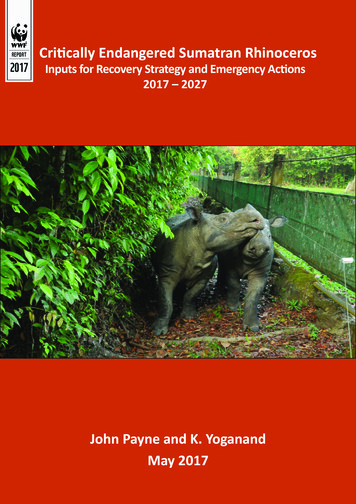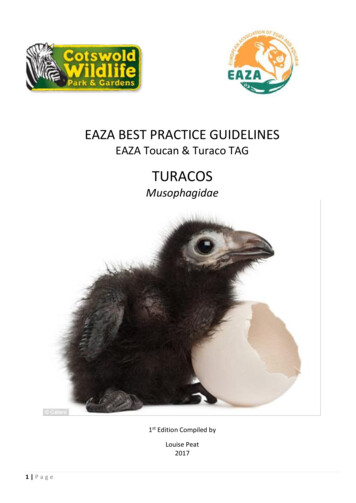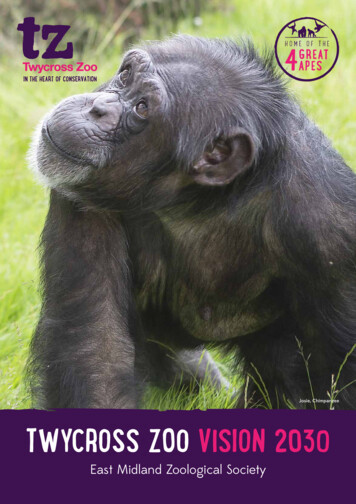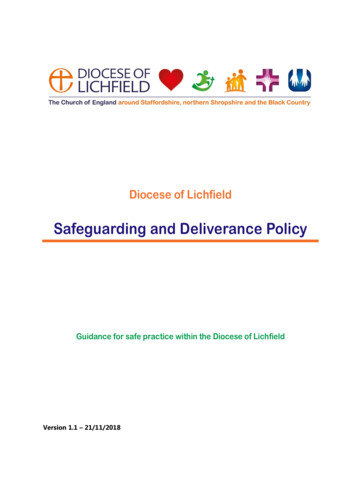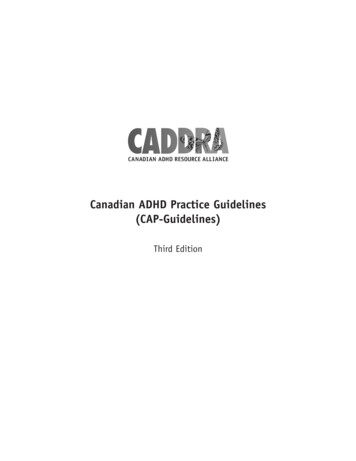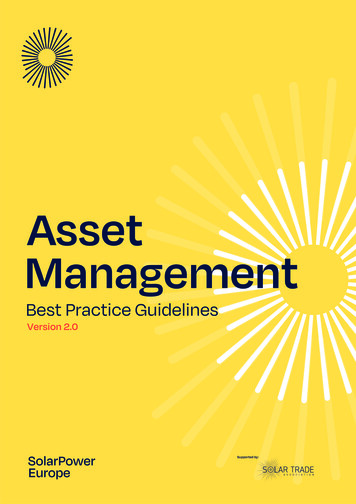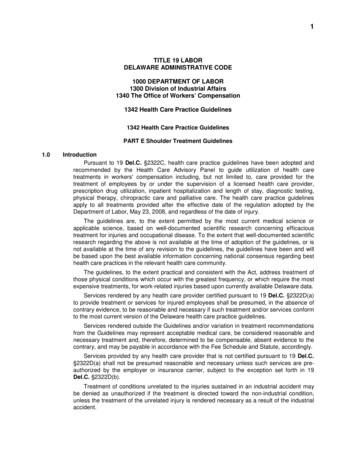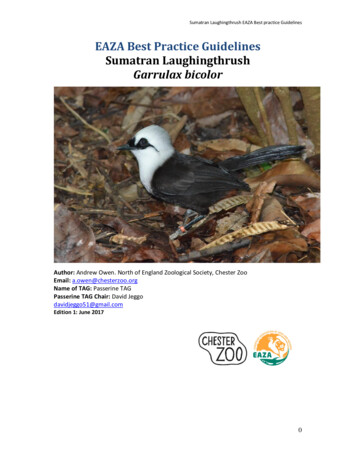
Transcription
Sumatran Laughingthrush EAZA Best practice GuidelinesEAZA Best Practice GuidelinesSumatran LaughingthrushGarrulax bicolorAuthor: Andrew Owen. North of England Zoological Society, Chester ZooEmail: a.owen@chesterzoo.orgName of TAG: Passerine TAGPasserine TAG Chair: David Jeggodavidjeggo51@gmail.comEdition 1: June 20170
Sumatran Laughingthrush EAZA Best practice GuidelinesEAZA Best Practice Guidelines disclaimerCopyright (June 2017) by EAZA Executive Office, Amsterdam. All rights reserved. No part ofthis publication may be reproduced in hard copy, machine-readable or other forms withoutadvance written permission from the European Association of Zoos and Aquaria (EAZA).Members of the European Association of Zoos and Aquaria (EAZA) may copy this informationfor their own use as needed. The information contained in these EAZA Best PracticeGuidelines has been obtained from numerous sources believed to be reliable. EAZA and theEAZA Passerine TAG make a diligent effort to provide a complete and accuraterepresentation of the data in its reports, publications, and services. However, EAZA does notguarantee the accuracy, adequacy, or completeness of any information. EAZA disclaims allliability for errors or omissions that may exist and shall not be liable for any incidental,consequential, or other damages (whether resulting from negligence or otherwise)including, without limitation, exemplary damages or lost profits arising out of or inconnection with the use of this publication. Because the technical information provided inthe EAZA Best Practice Guidelines can easily be misread or misinterpreted unless properlyanalysed, EAZA strongly recommends that users of this information consult with the editorin all matters related to data analysis and interpretation.EAZA PreambleRight from the very beginning it has been the concern of EAZA and the EEPs to encourageand promote the highest possible standards for husbandry of zoo and aquarium animals. Forthis reason, quite early on, EAZA developed the “Minimum Standards for theAccommodation and Care of Animals in Zoos and Aquaria”. These standards lay downgeneral principles of animal keeping, to which the members of EAZA feel themselvescommitted. Above and beyond this, some countries have defined regulatory minimumstandards for the keeping of individual species regarding the size and furnishings ofenclosures etc., which, according to the opinion of authors, should definitely be fulfilledbefore allowing such animals to be kept within the area of the jurisdiction of thosecountries. These minimum standards are intended to determine the borderline ofacceptable animal welfare. It is not permitted to fall short of these standards. How difficult itis to determine the standards, however, can be seen in the fact that minimum standardsvary from country to country.Above and beyond this, specialists of the EEPs and TAGs have undertaken the considerabletask of laying down guidelines for keeping individual animal species. Whilst some aspects ofhusbandry reported in the guidelines will define minimum standards, in general, theseguidelines are not to be understood as minimum requirements; they represent best practice.As such the EAZA Best Practice Guidelines for keeping animals intend rather to describe thedesirable design of enclosures and prerequisites for animal keeping that are, according tothe present state of knowledge, considered as being optimal for each species. They intendabove all to indicate how enclosures should be designed and what conditions should befulfilled for the optimal care of individual species.Citation:EAZA Best Practice guidelines for the Sumatran Laughingthrush Garrulax bicolor. Edition 1.Andrew Owen June 2017.1
Sumatran Laughingthrush EAZA Best practice GuidelinesSummaryThis is first edition of the Best Practice Guidelines for the Sumatran Laughingthrush is basedon the husbandry experiences of a number of dedicated aviculturists and institutions.This species has only been in aviculture for a relatively short time, (since the early 2000’s)and has only officially been a managed ESB species since 2011. This was upgraded to an EEPin September 2016. The basis of the current EEP captive population is derived from a smallnumber of wild-caught founders, which were sourced from private aviculturists by a fewEAZA institutions between 2004 and 2006.Many of the husbandry techniques contained herein have been developed by the author andcontributors working with this and other species of Laughingthrushes. The experiences ofprivate breeders are highly valuable and as such have also been incorporated into theseguidelines. Some aspects of these guidelines have been taken or modified from Dave Coles’excellent Laughingthrush breeders manual produced in 1990.The taxonomy used in this document follows: del Hoyo, J. & Collar, N.J. (2016) HBW andBirdLife International Illustrated Checklist of the Birds of the World. Volume 2: Passerines.Lynx Edicions, Barcelona.AcknowledgementsI am very grateful to the following for their contributions to the first edition of theseguidelines.Simon Bruslund, Tomaś Busina, Dave Coles, Jan Dams, Ian Edmans, Laura Gardner, VictoriaKaldis, Piet Kreeft, Javier Lopėz, Paul Morris, Robert Naeff, Tomaś Ouhel, Hannah Phillips,Tomaś Peś, Casey Povey, Florian Richter, Nigel Simpson, Holger Schneider, Anaïs Tritto,Antońin Váidl, Amy Vercoe, Jill Vevers and Andy Woolham.All photographs by Andrew Owen, unless otherwise stated.These Best Practice Guidelines were completed in June 2017.2
Sumatran Laughingthrush EAZA Best practice GuidelinesContentsEAZA Best Practice Guidelines1Section 1: Biology and Field n1.4Longevity44478Field Data1.5Zoogeography and Ecology1.6Population and Conservation Status1.7Behaviour1.8Diet and feeding behaviour1.9Reproduction9911131415Section 2: Management in 505160656571EnclosureFeedingGeneral BehaviourBreedingArtificial incubationHand-rearingCatching and handlingBehavioural enrichmentTransportationVeterinary considerations for health and welfareSection 3: References76Section 4: Appendices77Appendix 1:78Body condition scoring3
Sumatran Laughingthrush EAZA Best practice GuidelinesSection 1: Biology and field eiotrichidae (Laughingthrushes, Liocichlas & Hwamei)GarrulaxbicolorNoneThis species was re-categorised during a taxonomic revision of the Asian babblers(Timaliidae) in 2006 and was split from the White-crested Laughingthrush Garrulaxleucocephalus with which it was formally regarded as a subspecies (Collar 2006).English synonymsBlack-and-white Laughingthrush, Sumatra White-crested Laughing Thrush, White-crestedLaughingthrush.1.2MorphologyBody sizeBill (tip to gape)31.5 mm31.0 mm30.7 mm32.1 mm28.6 mm29.2 mmSexMaleMaleMaleMaleFemaleFemaleSkull57.9 mm57.6 mm56.9mm57.7mm54.2 mm55.3 mmTail49.1 mm49.2 mm48.9 mm48.8 mm49.0 mm48.8 mmWing137 mm134 mm134 mm136 mm122 mm124 mmTarsus132 mm130 mm129 mm131 mm127 mm128 mmMorphometric measurements of six captive Sumatran Laughingthrushes Garrulax bicolorWeightThere are no weights recorded for adult birds in the wild.In captivity the average weight for adult males is 113.5g with a variation of 95-148gcalculated from 95 samples from five EAZA institutions.The average weight for adult females is 107.6g with a variation of 95-130g calculated from21 samples from five EAZA institutions. However these weights do not take into4
Sumatran Laughingthrush EAZA Best practice Guidelinesconsideration the issue of obesity to which this species is particularly susceptible in captivity.The weights taken at Cikananga Conservation Breeding Centre (CCBC) in West Java, wherenormal healthy body condition scores were also taken may give a more accurate reflectionof what normal healthy weights should be for this species.Weights based on ‘Normal healthy’ body condition scores from 38 adult birds at CikanangaConservation Breeding Centre. (see appendix 1: Body condition scoring).MalesAverage: 106gRange: 97-116gFemalesAverage: 103gRange: 90-112gDescription24-28cm. The head, throat, neck and breast including the upper lore’s, are white, with glossyblack on the forehead and over nares and joining via lower lore’s, forming black “goggles”and distinctive “teardrop” over the lower ear-coverts behind the eyes. White feathers oncrown are frequently raised to form a low crest. There is a faint pale grey wash on the napeand the rear of the crest, the rest of the plumage is glossy brown-black. The iris is darkreddish-brown, the bill is black, the legs and feet including toes are blackish or greyish-black.The sexes are visually indistinguishable from each other.Juveniles are similar to adults, but with much white inter-mixed with dull brownish-blackunder-parts. The eyes are paler brownish than the adults.Adult Waddesdon Manor 20055
Sumatran Laughingthrush EAZA Best practice GuidelinesJuvenile 5 weeks old Prague zoo (Antońin Váidl).Juvenile Chester zoo – note yellow gape flanges and paler reddish-brown eye6
Sumatran Laughingthrush EAZA Best practice Guidelines1.3 VocalisationThis species is very vociferous, with male and females making a variety of different callsincluding the typical loud explosive maniacal laugh for which the family gets its name.Contact calls between a pair of birds are fairly quiet single “wah” notes uttered by bothsexes.A study on the vocalisation of this species in captivity at Cikananga conservation breedingcentre (Tritto unpublished report 2013) found that the vocalisation of the male includes twodifferent calls. The first call is mainly heard in the morning is a fairly loud melodious series ofnotes and tones and appears to be either female-directed or outsider-directed.The second call starts quietly and always occurs before a duet or appears to be a “request”to the female to duet. It starts low and slow and becomes louder and faster, building to anexplosive melodic series of flute-like notes with the female joining the duet with what can bedescribed as a high pitched machine-gun like chattering “Trriiiii” which lasts for severalseconds. A wing-shivering behaviour was also observed when the female was calling. Themale appears to almost always be the instigator of the duet. If the female does not join theduet, the male will stop and start again from the beginning.Females were normally quiet apart from when they joined the duet with the male. On therare occasions when females called alone, they used the same vocalisation pattern that isheard during the duet.Duets were often heard when there was some disturbance around the birds’ environmentsuch as keeper disturbance, a dog barking or a motorcycle passing by and one pair of birds’duet may trigger other pairs to explode into duets. These duets may be considered “alarmduets” and lasted longer (up to 14 seconds) than those performed in a quiet environment.The study found that birds were more vocal in the morning and that vocalisations were morefrequent when several pairs were kept in relatively close proximity to each other and hadvocal or visual contact with con-specifics. These pairs may be affirming their territories andstrengthening pair-bonds by performing frequent duets.The study also found that newly established pairs or pairs that had recently been moved tonew aviaries were more vocal than those that were bonded and were settled in anestablished environment or territory.Nesting pairs remain silent, even if other pairs can be heard.Although the purpose of the duets is not fully understood, it can be hypothesised that theymay be used for:· Mate-guarding – performed to advertise the mated status of the pair to potentialintruders and avoid rivals being attracted by a solo song.· Alarm/Distress – often performed after a disturbance. The aim could be to defend aterritory, alert a partner and confuse predators or as mutual reassurance after adisturbance.· Pair-bonding – whilst duets seem to be linked with strengthening long-term pairbonds, at Cikananga they seemed to be linked with the formation of the pair bond.Newly formed pairs duet more than established pairs and this may be ameasurement of individual quality. The duet would thus be a criterion for pairselection.· Reproductive synchrony – the duet may give the indication of the reproductive statusof the birds and their readiness to breed. By answering its partner, the bird would7
Sumatran Laughingthrush EAZA Best practice Guidelinesconvey information on its breeding cycle and its willingness to put effort intoparental care, territorial defence and other aspects of a partnership. When thissynchrony is achieved, the number of calls will decrease as the birds invest effort intobreeding behaviours such as nest building, incubation and rearing the young.Male vocalising with bill partially open1.4 LongevityThere are no longevity records for this species in the wild. The oldest living birds in captivityhave attained a minimum age of 17 years. Six wild caught adults (four males, two females)imported into Europe in 2000 were still alive in May 2017. One of these males (paired to ayounger captive-bred female), raised young at an age of at least 16 years. The oldestbreeding female was known to be at least 14 years of age.8
Sumatran Laughingthrush EAZA Best practice GuidelinesField Data1.5 Zoogeography and EcologyDistributionThe Sumatran Laughingthrush was originally distributed along the length of the mountainousspine of Sumatra, Indonesia, from Aceh in the north to Lampung in the south (van Marle andVoous 1988), and was reportedly common. Recent evidence suggests that it has undergonea considerable decline. It was known to be present at a small number of sites scatteredacross Sumatra, including Bukit Barisan Selantan National Park, Danau Ranau (SouthSumatra) (R. Thomas per C. R. Shepherd in litt. 2012), Batang Toru (North Sumatra) and UluMasen (Aceh) (N. Brickle in litt. 2007), and a single locality in Kerinci Seblat National Park (S.Högberg in litt. 2006), although recent surveys there have failed to find it (N. Brickle in litt.2007). A small group of three birds was camera trapped in Batang Toru (G. Fredriksson per C.R. Shepherd in litt. 2012).It has been photographed in the wild in the Alas Valley, Aceh, December 2010 by JamesEaton in the Gayo Highlands, Aceh, December 2013 and Leuser Ecosystem, Aceh, February2015 by Agus Nurza (Oriental Bird Club Images 2015).It is frequently seen in local wild bird markets (e.g. in Jambi and Medan in 2007, Shepherd2007, N. Brickle in litt. 2007). It is also frequently seen in the larger bird markets in Jakarta,Java (Shepherd 2007 and Owen 2008, 2011, 2012, 2013, 2014 pers obs.) and Denpasar, Bali(Owen 2013 pers obs. R. Switzer in litt. 2015) although numbers have declined in recentyears. Local traders and hunters report that it has become rarer (Shepherd 2007, 2011, N.Brickle in litt. 2007).From preliminary market surveys it is suspected that birds may still occur in themountainous areas of Sumatra including Aceh, Dairi, Riau, Tanah Karo and Sumatra Barat,however population may be low due to uncontrolled harvesting (T. Busina in litt. 2015).HabitatThis species is known from broadleaf evergreen montane forest from 750 – 2000m (withunsubstantiated reports of a lowland population in Berbak Game Reserve, Jambi). Due totrapping pressure it appears to be being pushed to more inaccessible areas and higheraltitudes. It lives in flocks in the middle and lower storeys of forest sometimes coming to theground.Robinson & Kloss (1918) described it as ‘very common in secondary jungle or in patches ofcultivation on the edges of old jungle’ although it ‘did not appear to frequent the primevalforest’, travelling ‘in parties of seven or eight from tree to tree’ and being ‘very restless’,giving a continual ‘harsh, screaming note’.Chasen & Hoogerwerf (1941) elaborated a little further, indicating the confinement of thespecies to ‘jungle from 800 to 2000 m, usually in the lower vegetation, never alone andsometimes congregating with other species, the whole forming a rather boisterouscompany’, but while ‘very lively’ the species ‘usually keeps hidden in the dense bush’.A study in 2015 of a population around Gunung Sinabung volcano in North Sumatra provinceby Tomas Busina, found the species occurred in primary broadleaf evergreen montane forestat altitudes between 1300 – 1600m above sea level.9
Sumatran Laughingthrush EAZA Best practice GuidelinesThe common trees of this lower montane forest habitat are represented by the followingfamilies: Fabales, Sterculiaceae, Moraceae, Melastomataceae and Malvaceae. Tree fernsand epiphytes are also common in this environment. This rugged habitat is steeply shapedby deep valleys with small rivulets and streams and is densely covered by trees with a closedcanopy with tree heights up to 35m.Very low levels of sunlight penetrate to the forest under-storey and forest floor. A thickshrub storey is very dense and is often impassable. Humidity is high and averagetemperatures during a 10 day period in January 2015 were 13.2 C at 0700 in the morning,16.1 C at 1300 and 15.3 C at 1900 in the afternoon. Maximum/minimum temperatures were16/9 C in the morning, 17/15 C at noon and 16/13 C in the evening (T. Busina in litt. 2015).Typical habitat of broadleaf evergreen montane forest. Gunung Sinabung, N. Sumatra. (TomasBusina).10
Sumatran Laughingthrush EAZA Best practice Guidelines1.6 Population and conservation statusRed List CategoryCriteria: A2cd 3cd 4cdPopulation size: 2500-9999Population trend: DecreasingDistribution size (breeding/resident): 218,000 km2Country endemic: YesAttributesRealm – IndomalayanIUCN Ecosystem -- Terrestrial biomeJustification of Red List CategoryThe species has suffered a very rapid, ongoing population decline due to trapping for tradecompounded by habitat loss. Local extinctions have been observed across much of the rangewithin the past 10-15 years concurrent with price increases and reduced availability in themarket. For these reasons Sumatran Laughingthrush is evaluated as Endangered.Population justificationThe species was reportedly common and widespread in 1988 but is now known to occur atfew sites throughout the range where only very small numbers have been located in the wildrecently. More than 45 km of transects in suitable habitat in 2013 returned only a singlerecord of the species (Eaton et al. 2015). Trappers in West Sumatra stated in 2015 that itremained in forests three days walk from a road (Eaton et al. 2015). The largest extent ofremaining habitat is in Aceh province, where the species is still relatively widespread thoughhighly localised and heavily trapped (Eaton et al. 2015). Recent bird tours to this area havelocated groups by the roadside, indicating that trapping pressure is lower in this culturallyseparate region of Sumatra (Eaton 2014). The paucity of records from the majority of therange indicates that the species now has a small population size.For these reasons it is believed to have a small population and is placed in the band 2,5009,999 mature individuals.11
Sumatran Laughingthrush EAZA Best practice GuidelinesTrend justificationNumbers in trade have been falling coincident with a rapid increase in the price per birdfrom 8-15 in 2007 to 90 in 2014 (Chng et al. 2014, Harris et al. 2015), and this data iscoupled with an expert review of the status of the bird in the wild concluding that it was'Severely Declining' (Harris et al. 2015). In the wild the species appears to have disappearedfrom several sites where it was being regularly recorded only a decade ago.ThreatsThe principal threat to this species is the illegal trade for the cage bird industry at a nationallevel (Eaton et al. 2015, Harris et al. 2015, Shepherd 2006, 2007, 2011). Prior to 2005 thewidespread sister species G. leucolophus was preferentially traded but international importsof wild birds were stopped in that year due the avian flu risk (Owen et al. 2014), whichappeared to drive a sudden surge of domestic bird trapping within Indonesia and G. bicolorwas the ready replacement at hand in Sumatra (Owen et al. 2014, Shepherd et al. 2006).Numbers observed in markets increased and 20-30 were regularly seen between 2008-2013,but in 2016 only 5 birds were observed and prices had increased to two birds for ca US 100(A. Owen in litt. 2016). As no quota has ever been set on the species, all trade in the speciesis illegal under Indonesian law. The vast majority of this trade is illegal and unregulated(Shepherd 2007, 2011). It may also have declined owing to deforestation within its range,though perhaps principally through increasing the percentage of the species range that isaccessible for trapping.Recent reports suggest that it may also be a target for recreational rifle hunters in someareas of its range (T.Ouhel in litt.2012).Conservation actionsConservation Actions UnderwayThe species currently receives no legal protection within Indonesia, however there is a zeroharvest quota, meaning that the species may not be removed from the wild.Captive breeding of this species has been successful on a small scale and is increasing inEurope for which an EAZA European Studbook (ESB) was formally established in 2011 andupgraded to an EEP (European Endangered Species Programme) in September 2016. Aregional ex situ captive breeding population was initiated in Java, Indonesia in 2008 by theCikananga Conservation Breeding Centre and as part of this regional programme, birds weretransferred to Taman Safari, Bogor in 2015. In 2015 3.3 unrelated birds were transferred toChester zoo to strengthen the genetic diversity of the European population. (Owen et al.2014, C. R. Shepherd in litt. 2012).In addition, since 2008, ZGAP (Die Zoologische Gelleschaft fur Arten-und Populationsschutze.V - Zoological Society for the Conservation of Species and Populations), WaddesdonManor, Chester zoo and other EAZA institutions have provided technical and financialsupport to the conservation breeding programme for this species at the CikanangaConservation Breeding Centre. Since 2008, Chester zoo has provided technical husbandryand veterinary advice to CCBC, which was formalized in 2015 with the signing of an MOUpartnership agreement between the two organizations.12
Sumatran Laughingthrush EAZA Best practice GuidelinesConservation Actions Proposed· Review the species' status in trade and consider listing under CITES.· Support measures to regulate the cage bird industry nationally in Indonesia andinternationally.· Surveys are urgently required to determine whether additional sub-populations stillpersist within the historical range. The species is currently only protected due to lackof a harvest and trade quota being established for it, and the absence of trappingpermits being granted.· Grant full legal protection for the species under Indonesian law. Support thedevelopment of captive breeding programmes with the aim of future reintroduction.CITES StatusThe Sumatran Laughingthrush is listed in CITES appendix II, which means regulatedinternational trade is permitted, provided it is done in accordance with national legislation.No Indonesian Laughingthrush species are currently listed in the appendices of CITES.Indonesia has been party to CITES since 1978. International trade in birds with Indonesia hasbeen forbidden since 2005 due to the risk of avian influenza (this ban remains in place forwild-caught birds from Indonesia) under the National Strategic Plan for Avian InfluenzaControl in Indonesia, Ministry of Agriculture (Shepherd 2010).Recommended citationBirdLife International (2017) Species factsheet: Garrulax bicolor. Downloaded fromhttp://www.birdlife.org on 21/05/2017ContributorsBrickle, N., Hogberg, S., Shepherd, C., Owen, A., Eaton, J. & Chng, S.1.7 BehaviourGroup compositionLittle is known about the group composition of wild Sumatran Laughingthrushes, Robinson &Kloss (1918) described it as ‘very common in secondary jungle or in patches of cultivation onthe edges of old jungle’ although it ‘did not appear to frequent the primaeval forest’,travelling ‘in parties of seven or eight from tree to tree’ and being ‘very restless’, giving acontinual ‘harsh, screaming note’. Robinson & Kloss (1924) said much the same thing, addingthat in habitat it was ‘also, but rarer, in old forest’, which was perhaps intended to revisetheir earlier proposition of its absence from ‘primaeval forest’, giving a flock size range of 6–10 (N. Collar in litt.)A study area on Gunung Sinabung was occupied in January 2015 by one SumatranLaughingthrush flock, which was made up of five individuals of unknown gender orrelationship. Given the nature of related species being cooperative breeder, it may bespeculated that these flocks may be extended family groups. Observations in August 201513
Sumatran Laughingthrush EAZA Best practice Guidelinesconfirmed two additional flocks (unknown number of individuals) surrounding the studyarea and presumptive home range of the “local” flock (T. Busina in litt.).1.8 Diet and feeding behaviourFood preferenceThis species has been seldom observed in the wild and there is little information on its foodpreferences, although they are probably much as for other montane Laughingthrushes.Other Laughingthrushes of the same genus feed mainly on insects and other invertebrates,including beetles (Coleoptera, of many families), moths and caterpillars (Lepidoptera),crickets and grasshoppers (Orthoptera), cockroaches (Dyctyoptera), mantises (Mantidae)and spiders (Araneae). Berries and seeds and also small reptiles and amphibians are eatenopportunistically. The stomach contents of five Sumatran Laughingthrush specimenscontained fruit seeds and insect remains, including of the families Buprestidae (jewelbeetles), Elateridae (click beetles), Rutelidae (scarab beetles) and Passalidae (bess beetles),with one cerambycid (longhorn beetle) Chasen & Hoogerwerf (1941).FeedingGarrulax Laughingthrushes are considered arboreal and terrestrial omnivores. Althoughinvertebrates form the bulk of the diet, berries, fruits and seeds are probably exploitedmainly opportunistically and seasonally (Collar & Robson 2007).This species, like many other Laughingthrushes is a bird of the middle and lower storey ofthe forest.During the study of a flock of five birds in the Sinabung volcano area of North Sumatra,Tomas Busina (in litt. 2015) observed them searching for insects and other invertebratesamong the vegetation of the mid, lower and occasionally, upper storey of broadleafevergreen forest. During the study period, they were never seen to eat any fruit or berriesand the individuals observed were never seen foraging on the ground.It forages, often in sociable flocks at the mid and low-storey and on the ground (although itwas not observed on the ground by Busina), where it moves in bounding hops, pecking atearth and rotten logs and tossing leaf litter aside in search of invertebrates.Laughingthrushes have strong legs and feet and are able to grasp and clamp food items suchas large insects and small vertebrates for further processing by the bill.14
Sumatran Laughingthrush EAZA Best practice GuidelinesSumatran Laughingthrush foraging for invertebrates in forest mid-storey Gunung Sinabung, NorthSumatra (Tomas Busina).At Cikananga Conservation Breeding Centre in Java, this species is occasionally offered smallfrogs which are quickly dispatched with repeated blows to the head, with the bird standinghigh on its legs to give it more power on each strike. Once killed the frog will be grasped inone foot and pulled apart with the bill and consumed.This behaviour was also observed by Schofield (2001) in a captive Lesser-necklacedLaughingthrush Garrulax monileger (Coles 2005).Laughingthrushes often associate with other species (including other Laughingthrushes) inmixed species flocks which move through the forest in search of invertebrate prey.Although the Sumatran Laughingthrush was mostly observed by Tomas Busina in singlespecies flocks it was occasionally seen in mixed-species flocks or bird-waves, which wererepresented by Black Laughingthrush Garrulax (Melanocichla) lugubris, SpectacledLaughingthrush Garrulax (Rhinocichla) mitratus, Sumatran Trogon Apalharpactes macklotiand Sumatran Drongo Dicrurus sumatranus (T. Busina in litt. 2015).1.9 ReproductionSexual maturityNo data are available from the wild. In Prague zoo a parent-reared male bird paired with anolder female successfully reared young at nine months of age (Vaidl pers. comm.)Similarly, at Chester zoo, Newquay zoo and at Cikananga conservation breeding centre,Sumatran Laughingthrushes have successfully reared young at 12 months of age.15
Sumatran Laughingthrush EAZA Best practice GuidelinesSeasonality of breedingDecember – April (Collar & Robson 2007). No further information available from the wild(see seasonality of breeding in captivity page 43).Courtship behaviourCourtship behaviour and mating has not been documented in this species in the wild.Courtship feeding has been observed in the White-throated Laughingthrush Garrulaxalbogularis in captivity with the female approaching the male in a slightly crouched posture,with the feathers fluffed and wings shivering as she was fed by the male. (Coles 2005).A similar behaviour has been seen in captive White-crested Laughingthrush Garrulaxleucocephalus. (Owen pers. obs.).Copulation in Sumatran Laughingthrushes was observed taking place on a fully constructednest at Chester zoo (Woolham pers. comm. 2017.)NestingNo nesting behavioural data is currently available for this species in the wild. (See page 44for nesting behaviour in captivity).For most babblers the roles of nest construction, incubation of the eggs and brooding of theyoung are shared between the male and female, although the relative proportions vary
Sumatran Laughingthrush EAZA Best practice Guidelines 2 Summary This is first edition of the Best Practice Guidelines for the Sumatran Laughingthrush is based on the husbandry experiences of a number of dedicated aviculturists and institutions. This species has only been in aviculture for a relatively short time, (since the early 2000's)

